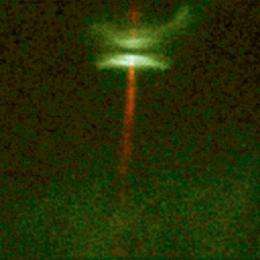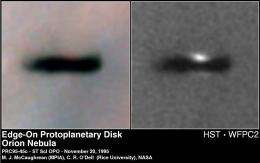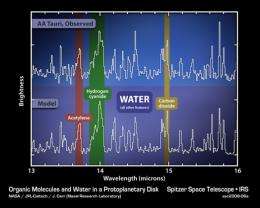A Drop in the Bucket

A new technique is being developed to detect water in the protoplanetary disks of other solar systems. If successful, it would help in our understanding of how habitable planets form.
The search for water on other planetary bodies has taken a giant leap forward in recent months. In November, NASA announced that it had found substantial quantities of water on the Moon. Earlier this month, the Cassini spacecraft obtained data about one of Saturn’s moons, Enceladus, that may confirm the presence of sub-surface liquid water.
While these missions scour our solar system for traces of water - a necessary condition for life - a group of scientists is looking beyond, at solar systems light years away. A recent study published in the journal Astrobiology described using infrared spectroscopy to model the dust surrounding young extrasolar stars to try to detect the presence of hydrous minerals called phyllosilicates.
One of the simplest examples of phyllosilicates is clay minerals. Water is an important part of their chemical structure.
“If you find phyllosilicates, you have most likely found liquid water,” says lead author Melissa Morris, a visiting professor in the Department of Physics, Astronomy and Materials Science at Missouri State University and an affiliate of Arizona State University’s School of Earth and Space Exploration. “The objective was to try to determine whether we could actually detect these wonderful signatures of hydrated minerals almost always produced by the interaction of liquid water with rock.”
In order to determine whether the surface of an extrasolar planet would contain water, scientists can look at what is called the protoplanetary disk - a disk of gas and dust surrounding a star during its early stages of development. Scientists think planets are born from protoplanetary disks through gravitational and electrostatic interactions between particles. So if scientists can determine the elemental composition of the dusty disks that orbit young stars, they should be able to predict what sort of planets will eventually form.
One school of thought suggests that the Earth acquired its surface water from asteroids or asteroid-like bodies that were present in its protoplanetary disk. The authors of this study used the same assumption for potential Earth-like planets in other solar systems. Therefore, if phyllosilicates are found in the protoplanetary disk of a young extrasolar star, the assumption is that water would most likely be found on the surface of planets that are later born within the disk. (Of course, as Mercury, Venus and Mars illustrate, other conditions will affect whether a rocky planet ultimately has water.)
The scientists hope to someday use instruments such as the Spitzer Space Telescope and the Stratospheric Observatory for Infrared Astronomy (SOFIA) to determine the composition of exozodiacal dust in extrasolar protoplanetary disks. Before that can be done, however, scientists must first determine if detection of particular minerals in these distant systems is even possible. This study helps scientists determine what signatures to look for in disks.
The composition of the dust is identified by studying its emission features. A common procedure is to use infrared spectroscopy to identify substances by the infrared wavelengths they absorb or emit. This procedure is often used to detect water on planetary bodies.

Morris and her colleagues began by modeling the infrared emission features of dust that did not contain hydrated minerals, or phyllosilicates. They then changed the mineral mixture by adding phyllosilicates amounting to three percent of the total mixture.
In the paper, Morris and her co-author Steve Desch of Arizona State University claim that unique features indicative of phyllosilicates in the mid-infrared spectra should make it possible to detect those minerals in protoplanetary disks.
Scott Sandford, a research astrophysicist at the NASA Ames Research Center in California who has experience conducting spectroscopy in meteorites, thinks that proving the presence of phyllosilicates in a protoplanetary disk could be a challenge. It would be an especially difficult task if phyllosilicates only make up a small portion of the disk material, or if a variety of phyllosilicate minerals are present.
“It is somewhat difficult to identify phyllosilicates when they are present in mixtures because they are relatively featureless as opposed to other minerals, which have a lot of structural features in their spectrum,” says Sandford.
Morris says the outcome of this study shows only that, based on the computer models, it should be possible to detect the presence of phyllosilicates in protoplanetary disks. It is only the first step in the detection of water in other solar systems.
“My part was developing the model to determine whether it could be done,” says Morris. “What instruments are available? Of the instruments we have, do they have the resolution?”

The next step, which Morris has already begun, is to apply this technique to actual data. Morris is now comparing the models to data obtained from the Spitzer Space Telescope.
Sandford says that will be the real test.
“The basic idea they are espousing is a perfectly good one,” says Sandford. “I'm personally kind of skeptical that you can locate the phyllosilicates in disks to the level they suggest. How applicable are those models to the real world? In any event, the only way to find out is to try -- and they have done the intial ground work to do that.”
Morris says this type of research is also important in understanding how planetary systems form in general.
“I’m a huge advocate for looking for water in our own solar system,” says Morris, “but just to understand the process of planetary system formation, we need to go outside our solar system and look at other systems as well.”
Source: Astrobio.net


















